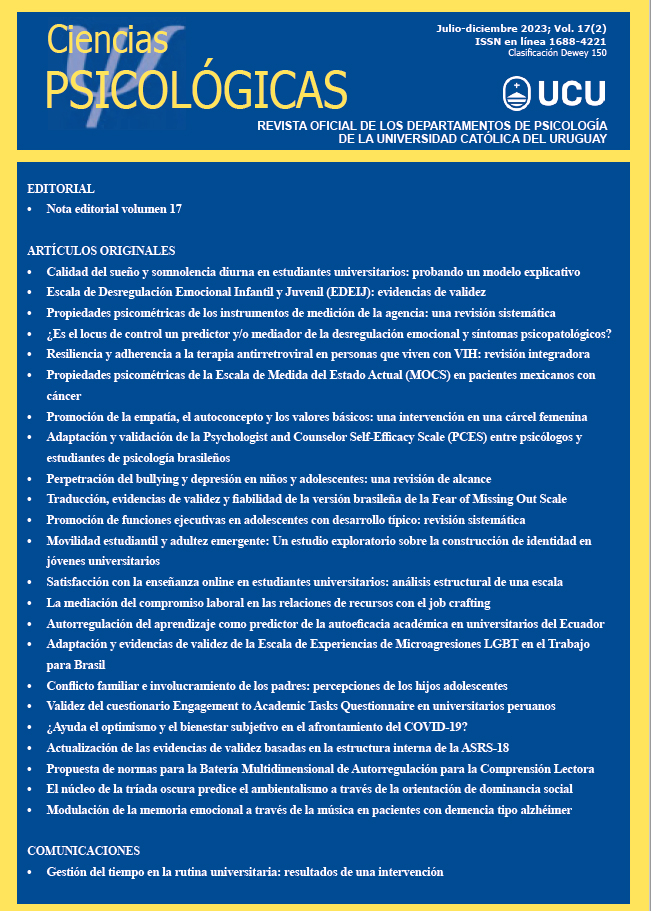Traducción, evidencias de validez y fiabilidad de la versión brasileña de la Fear of Missing Out Scale
DOI:
https://doi.org/10.22235/cp.v17i2.2835Palabras clave:
Fear of Missing Out, propiedades psicométricas, análisis factorialResumen
Se examina en este estudio el fenómeno del Fear of Missing Out (FoMO), caracterizado por la angustia causada por la percepción de estar excluido o no participar en actividades en las que están involucrados los compañeros. Se utiliza la Escala FoMO, compuesta por 10 ítems, para medir los niveles de este sentimiento. La investigación tuvo como objetivo traducir, adaptar y validar la Escala Fear of Missing Out para el contexto brasileño. Para lograr este objetivo, el estudio siguió dos etapas metodológicas distintas: la primera se refirió a la traducción y adaptación, mientras que la segunda abarcó la aplicación de la escala, acompañada de un análisis de la validez de contenido y de constructo. En la fase inicial, el proceso involucró la traducción en sí, seguida de la retrotraducción y la evaluación posterior por parte de expertos y del público objetivo. Avanzando a la segunda etapa, se llevó a cabo un análisis factorial exploratorio (AFE) utilizando el software Factor, que incluyó a 646 participantes de entre 18 y 63 años (M = 32.60; DE = 11.84). El análisis factorial exploratorio reveló la presencia de una única dimensión en la escala, en línea con la estructura original. Además, el estudio proporcionó dos formas de evidencia de validez para el instrumento, considerando su novedosa aplicación en el contexto brasileño. La capacidad de utilizar esta escala en este escenario abre la puerta a estudios transculturales que abordan este tema.
Descargas
Citas
Al-Menayes, J. (2016). The fear of missing out scale: Validation of the Arabic version and correlation with social media addiction. International Journal of Applied Psychology, 6(2), 41-46.
Alt, D. (2015). College students' academic motivation, media engagement and fear of missing out. Computers in Human Behavior, 49, 111-119. https://doi.org/10.1016/j.chb.2015.02.057
Borsa, J. C.; Damásio, B. F.; Bandeira, D. R. (2012). Adaptação e validação de instrumentos psicológicos entre culturas: algumas considerações. Paidéia, 22(53), 423-432. https://doi.org/10.1590/s0103-863x2012000300014
Brown, T. A. (2006). Confirmatory factor analysis for applied research. The Guilford Press.
Casale, S., & Fioravanti, G. (2015). Satisfying needs through social networking sites: A pathway towards problematic Internet use for socially anxious people? Addictive Behaviors Reports, 1, 34-39. https://doi.org/10.1016/j.abrep.2015.03.008
Casale, S., & Fioravanti, G. (2020). Factor structure and psychometric properties of the Italian version of the fear of missing out scale in emerging adults and adolescents. Addictive Behaviors, 102, 106179. https://doi.org/10.1016/j.addbeh.2019.106179
Elhai, J. D., Yang, H., Fang, J., Bai, X., & Hall, B. J. (2020). Depression and anxiety symptoms are related to problematic smartphone use severity in Chinese young adults: Fear of missing out as a mediator. Addictive behaviors, 101, 105962. https://doi.org/10.1016/j.addbeh.2019.04.020
Ferrando, P. J., & Lorenzo-Seva, U. (2018). Assessing the quality and appropriateness of factor solutions and factor score estimates in exploratory item factor analysis. Educational and Psychological Measurement, 78, 762-780. https://doi.org/10.1177/0013164417719308
Floyd, F. & Widaman, K. (1995). Factor analysis in the development and refinement of clinical assessment instruments. Psychological Assessment, 7, 286-299. https://doi.org/10.1037/1040-3590.7.3.286
Gil, F., Del Valle, G., Oberst, U., & Chamarro, A. (2015). Nuevas tecnologías -¿Nuevas patologías? El smartphone y el fear of missing out. Aloma: Revista de Psicologia, Ciències de l’Educació i de l’Esport, 33(2), 77-83. https://doi.org/10.51698/aloma.2015.33.2.77-83
Gökler, M., Aydın, R., Unal, E., & Metintas, S. (2016). Determining validity and reliability of Turkish version of Fear of Missing out Scale. Anatolian Journal of Psychiatry, 17(1), 53. https://doi.org/10.5455/apd.195843
Laros, J. A. (2005). O uso da análise fatorial: algumas diretrizes para pesquisadores. Análise fatorial para pesquisadores, 1, 145.
Lorenzo-Seva, U., & Ferrando, P. J. (2019). Robust Promin: a method for diagonally weighted factor rotation. Liberabit: Revista Peruana de Psicología, 25(1), 99-106. https://doi.org/10.24265/liberabit.2019.v25n1.08
Milyavskaya, M., & Koestner, R. (2011). Psychological needs, motivation, and well-being: A test of self-determination theory across multiple domains. Personality and Individual Differences, 50(3), 387-391. https://doi.org/10.1016/j.paid.2010.10.029
O’Connor, B. P. (2000). SPSS and SAS programs for determining the number of components using parallel analysis and Velicer's MAP test. Behavior Research Methods, Instrumentation, and Computers, 32(3), 396-402. https://doi.org/10.3758/bf03200807
Pasquali, L. (2009). Psicometria. Revista da Escola de Enfermagem da USP, 43(spe), 992-999. https://doi.org/10.1590/s0080-62342009000500002
Perrone, M. A. (2013). #FoMO: establishing validity of the fear of missing out scale with an adolescent population. Alfred University.
Przybylski, A. K., Murayama, K., DeHaan, C. R., & Gladwell, V. (2013). Motivational, emotional, and behavioral correlates of fear of missing out. Computers in Human Behavior, 29, 1841-1848. https://doi.org/10.1016/j.chb.2013.02.014
Reeve, J. (2006). Motivação e Emoção (4a ed.). LTC.
Roberts, J. A., & David, M. E. (2020). The social media party: Fear of missing out (FoMO), social media intensity, connection, and well-being. International Journal of Human–Computer Interaction, 36(4), 386-392. https://doi.org/10.1080/10447318.2019.1646517
Ryan, R. M., & Deci, E. L. (2000). Self-determination theory and the facilitation of intrinsic motivation, social development, and well-being. American Psychologist, 55(1), 68-78. https://doi.org/10.1037/0003-066x.55.1.68
Sette, C. P., Lima, N. R., Queluz, F. N., Ferrari, B. L., & Hauck, N. (2020). The online fear of missing out inventory (ON-FoMO): Development and validation of a new tool. Journal of Technology in Behavioral Science, 5(1), 20-29. https://doi.org/10.1007/s41347-019-00110-0
Skierkowski, D., & Wood, R. M. (2012). To text or not to text? The importance of text messaging among college-aged youth. Computers in Human Behavior, 28, 744-756. https://doi.org/10.1016/j.chb.2011.11.023
Tanhan, F., Özok, H. İ., & Tayiz, V. (2022). Fear of missing out (FoMO): A current review. Psikiyatride Guncel Yaklasimlar, 14(1), 74-85.
Timmerman, M. E., & Lorenzo-Seva, U. (2011). Dimensionality Assessment of Ordered Polytomous Items with Parallel Analysis. Psychological Methods, 16, 209-220. https://doi.org/10.1037/a0023353
Wegmann, E., Oberst, U., Stodt, B., & Brand, M. (2017). Online-specific fear of missing out and Internet-use expectancies contribute to symptoms of Internet-communication disorder. Addictive Behaviors Reports, 5, 33-42. https://doi.org/10.1016/j.abrep.2017.04.001
Descargas
Publicado
Cómo citar
Número
Sección
Licencia
Derechos de autor 2023 Universidad Católica del Uruguay

Esta obra está bajo una licencia internacional Creative Commons Atribución 4.0.
















